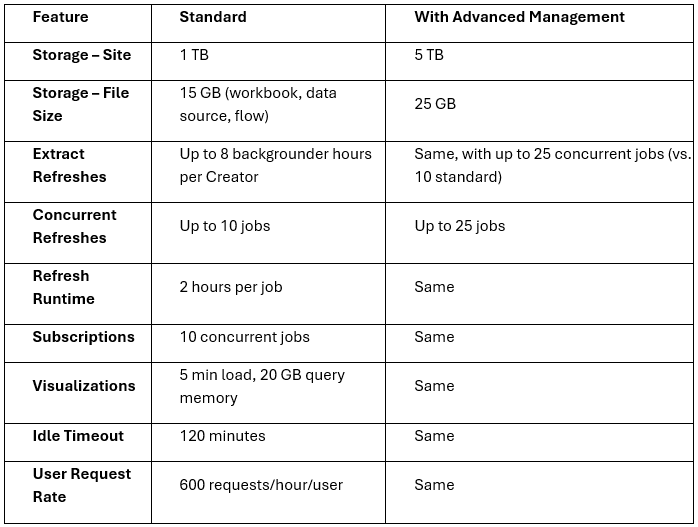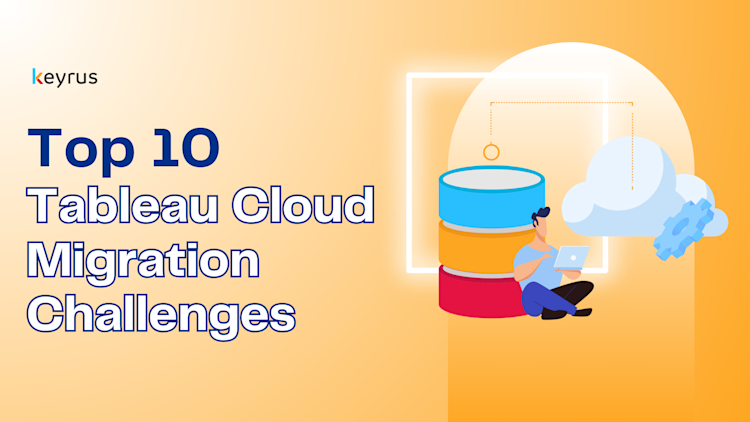It's the question you've probably been asking yourself: Why should I migrate from Tableau Server to Tableau Cloud? For all its gravitas and pioneering in the BI platform world, Tableau Server and its administration is not a task that comes with a light workload. Hosting overhead, coordinating upgrades and patches among stakeholder teams, allocating and troubleshooting machine resources and processes… the list can be extensive. The goal for moving to Tableau Cloud is to help ease or eliminate those line items while giving users access to the best experience possible.
With Cloud there is no infrastructure to manage. You’re within a completely cloud hosted environment built on top of Salesforce’s Hyperforce, giving you the best in resiliency, availability, and trust. Upgrades are automatically applied, so you’re always on the latest and greatest version, saving your teams from overnight or multi-day upgrade processes, while also giving your users access to the new and exclusive AI features like Tableau Next and Pulse.
It’s not a stretch now to say that Tableau Cloud gives you enterprise grade security. HIPAA and PCI compliance, site based SAML, SCIM and MFA, Cloud Manager, Connected Apps, Private Connect, and more all make sure that your data and its transmission and access are all under control. Features like Cloud Manager and SCIM also make sure that scalability is easy. Create up to 50 sites with individual authentication protocols and automatic user creation. Scale your data and viz usage as well with all the tools and analysis needed to make sure you’re serving your users how you decide.
Top 10 Most Common Challenges
With a planning and executing process like that, and numerous possibilities for your Tableau Server setup, these are some of the biggest pitfalls or things to be on the lookout for.
1. Tableau Versions (especially TDE data sources)
If you’re still using .tdes, then it’s a good thing you’re reading this article as a whole. Tableau moved to its Hyper Extract Engine in 2018 and has deprecated the use of .tde extracts on Tableau Cloud. Before migrating, all your .tde published or embedded datasources will need to be moved to Hyper, which must be converted manually
2. Tableau Cloud Site Capacity
Tableau Cloud does impose some limits on capacity and usage due to its nature as a shared platform. These limits vary based on licensing and are shown here:

Additional limits can be found here: Tableau Cloud Site Capacity
3. Private Data Connections
Tableau provides Bridge and Data Connect as ways to reach your most sensitive data that cannot live in the Cloud. Due to the nature of data connections and network architecture for security and housing, this setup can rival that of the Cloud migration as a whole if the need to connect to a large number of private data sources is necessary. Read more about the setup and usage of Tableau Bridge and Data Connect.
4. Custom Scripts
Rest, Hyper, Metadata or other API usage must be ported over to Tableau Cloud. There will be new URLs to reference and you’ll need to authenticate against the new environment. If your organization relies on a large amount of backend automation against Tableau Server, then making sure the necessary scripts will still run on Cloud is paramount.
5. Live Data Connections
Many users have gotten used to their most up to date data being available all day in Tableau Server. Depending on the database or data source that you’re using, that may require Tableau Bridge or Data Connect to foster the live connection similar to the private data setup. Cloud systems like Snowflake are beneficial here, as the live communication between Cloud and Snowflake is one that can happen automatically with security allowances.
6. Advanced Management License for CMT
As mentioned, the Content Migration Tool is powerful, but it does require a very high level of licensing in both of your environments. Manual migrations can be arduous and error prone, so working with a partner like Keyrus who has access to the CMT is an enormous value in time saving and an increase in accuracy and iteration in moving content.
7. IP/Whitelisting
Tableau Cloud lives within specific IP ranges. To ensure your connections to data and any other systems that might communicate with Tableau aren’t interrupted, you’ll need to update the IP allowlists that contain your current Tableau Server values. Failure to do this can lead to failed connections and user disruption.
8. Embedded Content
If your Tableau dashboards are embedded within other applications or portals, migrating to Tableau Cloud may require adjustments. Changes in URLs, authentication methods, and access permissions need to be addressed to ensure seamless integration post-migration.
9. User Training & Change Management
Migrating to Cloud means changes for users, and the goal is to mitigate and foster that change as much as possible. It’s possible and even likely that all levels of users will encounter something new for a workflow. Admins, developers, and end users all will need support for a smooth transition. Tableau+ with Premium Support is an excellent resource to have to both kick off and make your Cloud users flourish moving forward with its added educational resources
10. Alerts, Refreshes, Subscriptions, Custom Views
While most actual content can be moved without a problem, the accompanying actions and maintenance do not always port over to Tableau Cloud. Jobs like Subscriptions and Alerts will not come over with the CMT, nor will any Custom Views any user has created. Keyrus’s migration process does automatically account for public Custom Views and is capable of saving your individual users time and energy in recreation.
Conclusion
Migrating to Tableau Cloud is as much a strategic effort as it is a technical one. More so than just the roadmap and project management, it’s an opportunity to rethink how Tableau is organized and used as a whole in your organization. Even with challenges like private data or manual processes like URL and scripting changes, the right preparation and support will assist in a beneficial transition and maintenance of sanity for all involved.
Whether you’re thinking about it, planning for it, or in the middle of it and realizing you’re needing a hand, Keyrus has helped more organizations than any other partner migrate and optimize their Tableau environments, giving users the ability to expand their usage of Tableau and confidently take the next step in their analytics journey.
